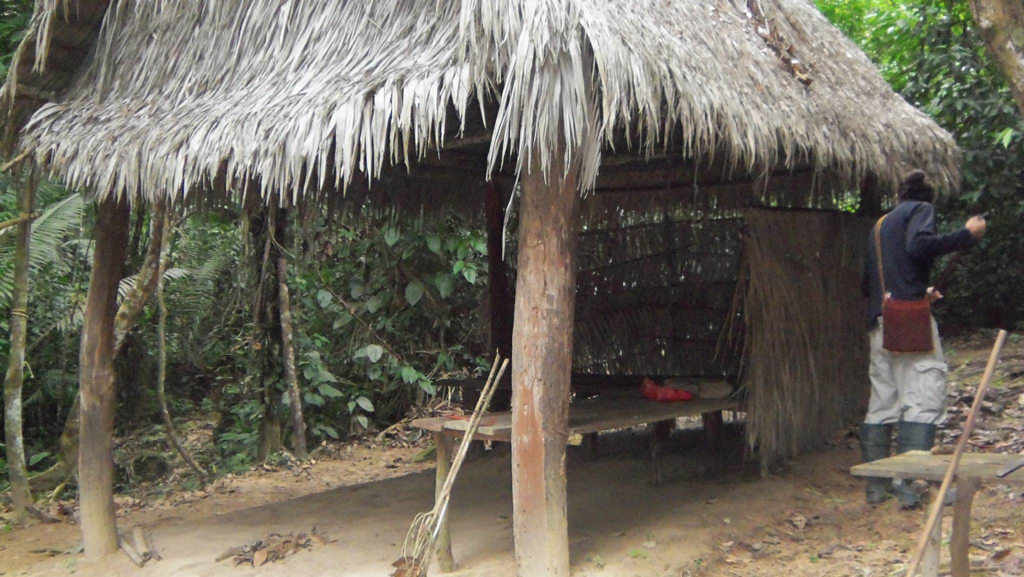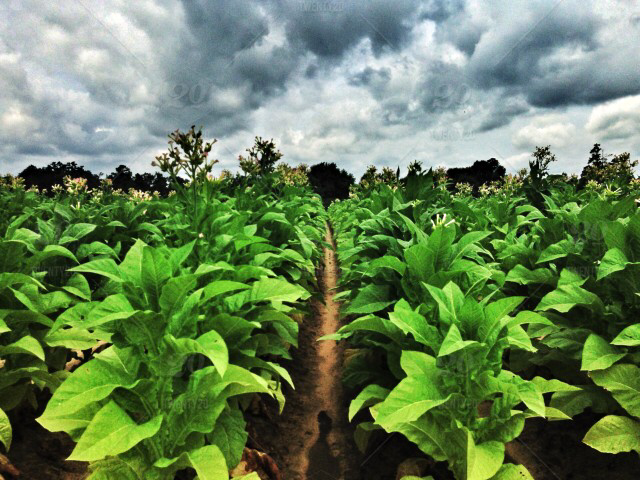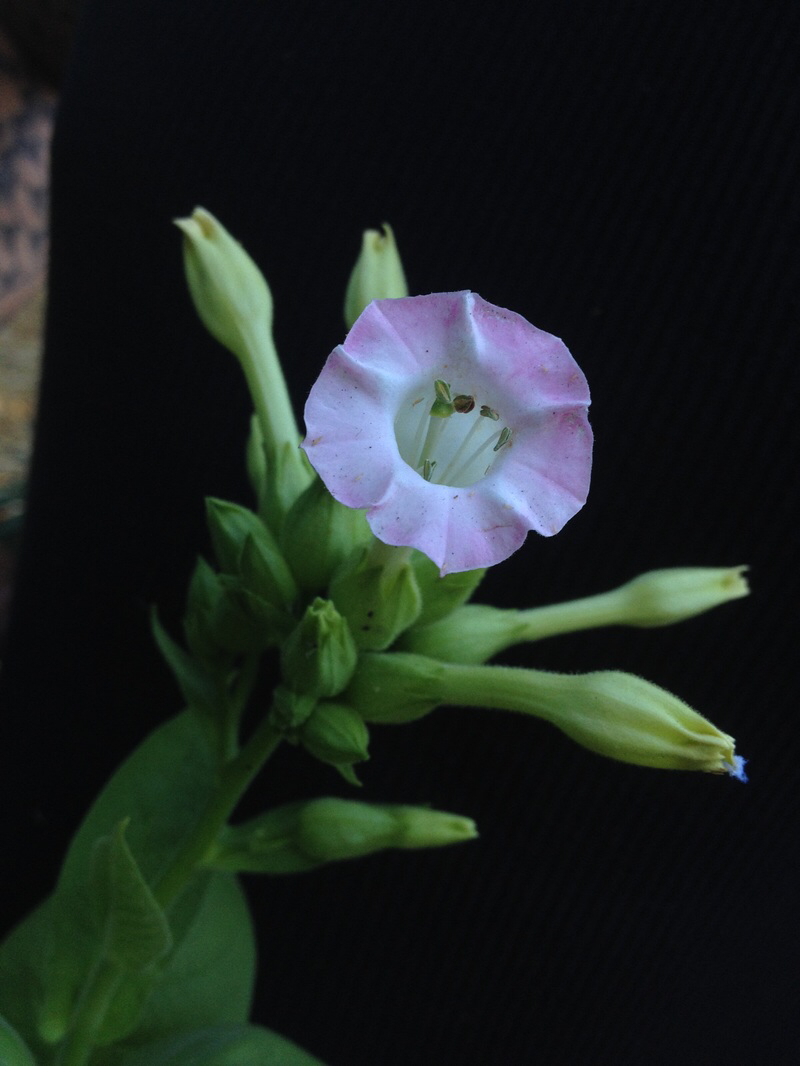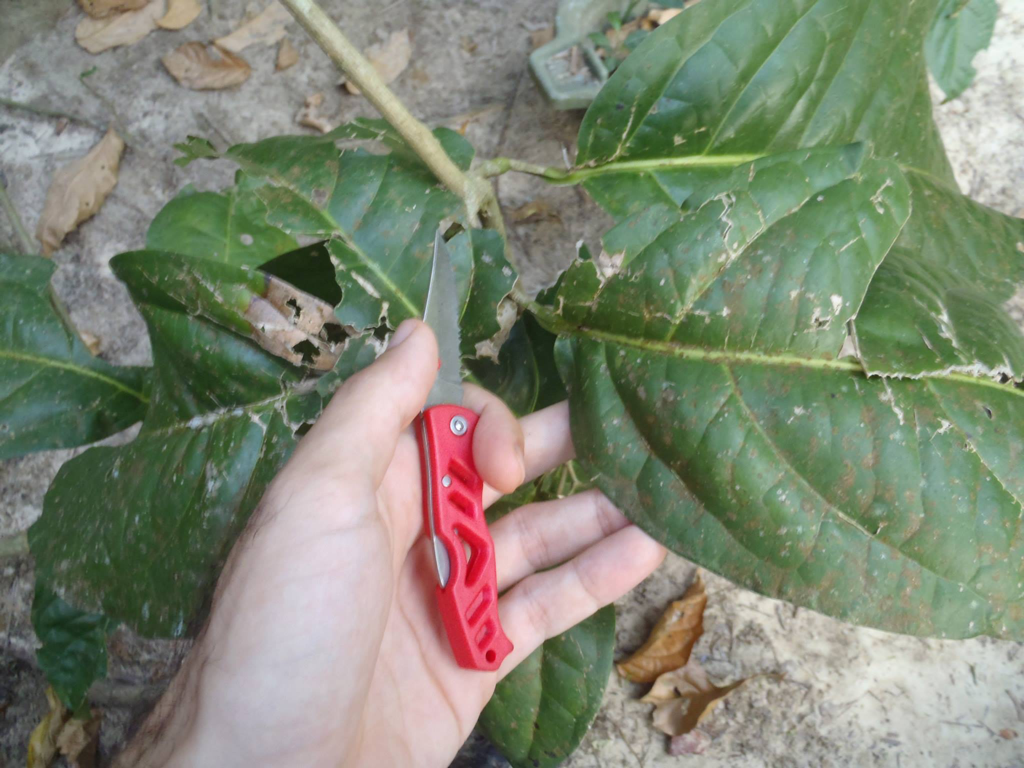Prelude: In Isolation circa 2013
The quiet evening song grows into a cacophony of noisy nocturnal dwellers as the inky darkness of the waning moon takes hold of the densely vegetated landscape of the Peruvian Rainforest. Hayy is alone in a tambo or a choza (Quechua terms for huts used for living in isolation during plant fasts) that has four thick wooden posts, a thatched hut made of leyarina (a type of palm leaf), and a foam mattress placed on top of a wooden platform with a mosquitero (mosquito net) around it. No walls and no floor, just the open air and sandy jungle soil.
A machete remains by Hayy’s side for the twenty days of his isolation as a kind of mental comfort for fear of some kind of unexpected animal attack, but it turns out that though it is useful as a weight to hold down the mosquitero and as a tool to clear dense vegetation on hikes during the day, it isn’t used for much else. Apart from water from a nearby stream and food (boiled green plantains and rice without any seasoning) delivered once a day by the curandero’s apprentice, the most important thing to Hayy unexpectedly turns out to be tobacco. To mark territory against animals (and spirits, as the natives would say), to drive away hornets that had made a nest close to his bed, to deter little gray scorpions seeking shelter on the platform Hayy’s bed was on during rainstorms, as mosquito repellent, as anti-itch salve, antiparasitic tea, mouthwash, and yet also, according to the almost all native Amazonian cultures, tobacco is used as a way to amplify prayers and intentions.
Myth and Context
The spirit of the tobacco. It’s a spirit because the Tobacco, it was a person like us that did some diets and it transformed itself into the spirit of the Tobacco. The Tobacco works, because for us, the Tobacco symbolizes the director of all the plants, the chief healer of all the plants in general. Because, with the Tobacco we give...the energy to the plants. That’s why we blow on the plants when we drink them, and also to chase away the bad spirits.
The Tobacco has been used since ancestral times...The Tobacco is essential in life, to live and to do the cleansing of our homes.
-Juan Flores, a traditional vegetalista curandero (Tonkiri, 2015)
It is Day 1 and Hayy is soaked in sweat from the three hour journey from Pucallpa, Peru to this bit of virgin rainforest. An important lesson is learned with the first rush of joy as he pours cold water over his head under the open sky: the jungle is insufferable without cold showers. As the stupor of heat and stickiness wears off, it seems the bugs are a little less interested in him as well, and he takes a disencumbered look at his surroundings. The steam from the boiling river, Shanay-Timpishka in the Ashaninka tongue, to his left rises with the breeze and disperses over the thatched wooden structure standing amongst the trees about fifty feet to his right. Hayy’s first impression written in his journal of the large cabaña is that it is “sturdy, neat, pretty, natural, and full of thoughtfulness.” Three quartos (rooms) below and three on the second story are accessed by a dangerously thin and steep set of stairs that also sway a bit; this second more informed impression leads Hayy to write, “maybe the structures are not as sturdy as they seem.” Hayy notes how, just as with his own family back home, shoes are always removed before entering any housing structure. Inside, everything is handmade and has an endearing quality in its simplicity of squares and rectangles, apparent in the imperfections of light-brown, chainsaw-cut wood making up the floor, ceiling, wall boards, tables, benches, beds (always covered by mosquito nets) and shelves. The windows are open with see-through screening and the doorway is bare; days later a thin sheet is hung for privacy regaled in the Shipibo-Conibo artisanal designs that have become the poster art for the Amazonian cities of Peru. Paths have been cleared between the plants and trees to specific destinations like outhouses; the land is well tended by the workers who continuously rake away leaves and chop undesirable plants with machetes. There is no grass because the rainforest is indeed a wet-desert, the dirt is sandy and the plants and trees that grow in it are specially adapted to this quality.
Plants Spirits: an anthropological look at terminology
Some people laugh, thinking it is the ultimate gimmick that there are companies trying to sell “organic” tobacco. “Tobacco is tobacco,” a drug and a killer...right?
The tobacco species Nicotiana tabacum “containing all the U.S.-grown commercial tobacco types-is a so-called amphidiploid; meaning, in it are combined the chromosomes of two species which have been hybridized in the past” (Hahn, 2011: 185). In the Peruvian Amazon one will find the genetically unaltered “Nicotiana rustica L.” (Kamal Kishore, 2014:3). Besides these two tobacco strains used for comparison in this paper there are over seventy species of tobacco documented by taxonomists. It is not in the scope of this paper to argue whether GMO or non-GMO tobacco is better for health or not. The fact simply is that this plant is a robust and highly successful biological organism with many different manifestations that extends far beyond the encapsulated conception of it. Tobacco cultivation “has a history of about 8,000 years” (Kishore, 2014:3), so one can barely imagine how far back Tobacco’s biological history extends.
The plants used in the Mestizo Vegetalismo tradition of the descendants of once purely indigenous societies of the Peruvian Amazon are considered plant masters, plant teachers, and healing plants (Shirazi, 2018:1). A curandero (traditional medicine practitioner) also firmly believes that each of these “master plants” has a spirit, and Tobacco is one of the most important beings in this cosmology. Now instead of jumping to the surface-level conclusion that these people are superstitious and relating unimportant information about plants, one must take an anthropological look at what is happening on a deeper level of cultural organization and maybe even pertinent [factual] data in terms of medicine and biology. In Hayy’s case during his time in the Amazon spending time with vegetalisto curanderos he noticed a clear distinction in how a Peruvian citizen- who lives not ten minutes away from the Peruvian Amazon but has never crossed the river and has never partaken in the traditional practices of Amazonian Vegetalismo -talks of “spirits.” It is fundamentally different when a maestro of vegetalismo speaks of a plant spirit. We have to purify our lexiconical associations for a moment when we, as anthropologists, hear a word like “spirit,” and consider that maybe the native practitioner is using a term within the constraints of her own lexicon to describe a phenomenon. This phenomenon is one that the curandero experiences, phenomena that may be discoverable just as we have revealed the unseen through different scientific instruments, i.e. radio waves, infrared, molecules, atoms, etc. Perhaps vegetalistas are describing forces in the botanical order of plants and the complex infrastructure of the rainforest when they speak of “spirits.” There is often reference to the “laws of the jungle” in Amazonian curanderismo where the icaros (sacred calling songs) request the plants for instruction on “las leyes que gobiernan en la selva”- the laws governing in the jungle -(Shirazi, 2018:2).
Implications
So what does this all mean for the Tobacco consumer, in the United States for example? When looking at the mestizo vegetalisto system of traditional medicine we also find that the more powerful a plant spirit is, the more important it is, and ultimately, the more dangerous it is. So it is within mestizo culture that a glaring disclaimer is written, a cautionary approach, to Tobacco. However, their caution doesn’t manifest as “just say no” policies and ostracization of the “dangerous,” instead it is something to be understood, related to in a healthy way, and furthermore allied with. Levi Strauss spoke of something similar he discovered among the Bororo, an indigenous culture of Brazil, about their ideas of sacrifice to the medicinal plant which fits into a larger worldview of a lifeforce, that has a give and take structure, which Strauss found was a “sensible way of being” (Strauss, 2008). When presented with certain language that a culture uses i.e. “spirits”, “mother earth,” “magic,” “energy,” the reductionist scientist, or even the average western individual, recoils and judges harshly (and other’s take it too literally and run with it, which is a discussion for another paper). To consider these terms as part of a sensible tradition, or furthermore, a sensible way of being for anyone, one must look to the context beyond the surface level of the words themselves. This inherent shift in perception in the “westerner’s” perception of terms like “spirit” may aid in her approach to substances, realizing that this is not simply dead matter to be abused, but a complex relationship to engaged in.
Today, beyond anthropology, the western materialist has the benefit to look into data coming out of the natural sciences that may help to shift his perception. In the book Brilliant Green it is discussed “that plants possess a “brain”...and that even the simplest plant organisms can feel and react to external stresses, has been proposed over the centuries by numerous philosophers and scientists. From Democritus to Plato, from Fechner to Darwin...some of the most brilliant minds of all time have been exponents of the intelligence of plants” (Mancuso, 2015:1). It is difficult for humans to understand plant life forms because evolutionarily our trajectories have been very different, “Like all animals, humans are endowed with unique organs, and thus every human being is an indivisible organism. But plants are sessile- they can’t move from one place to another -and so they’ve evolved in a different way, constructing a modular body without individual organs” (Mancuso, 2015: intro p. 2). Evolutionarily this is a very successful strategy: “if an herbivorous predator removed an organ whose function couldn’t be performed by another part of the plant, that ipso facto would cause the plant’s death” (Mancuso, 2015: intro p. 2). This book goes into much more detail about the neurobiology of plants (Yes, of plants!), and insights about how as human technology advances it increasingly mimics nature; think of solar panels, or how the internet is based on previously successful biological systems of plant and mycological networks.
How to: create a relationship with a powerful plant in Vegetalisto tradition
The idea behind uniting research on plants on all fronts is to raise awareness that we are surrounded by beings that have been around on the earth for much longer than us: on the order of millions of years. Then we can begin to consider that we are engaging in literal relationships with plants like the infamous Tobacco. Here it might be pertinent to include a warning about the romanticization of nature, or plants. Just because it is natural, doesn’t mean it is safe right off the bat. “Be careful, he is very powerful” Enrrique, a traditional vegetalisto curandero says to Hayy when Hayy asks to enter into a traditional fast with tobacco. We must remember these living beings have figured out ways to survive over the course of eons, in all of the most dangerous environments on the planet, among all sorts of dangerous organisms. To be clear, plants are not just peaceful green hippies of the natural world living through the onslaught of violent species, looking at Tobacco addiction stats around the world one can indeed include this plant in the category of “dangerous organism.” Reflecting on the term maestro (master) applied by vegetalistos to particular plants means that this plant has mastered something, or many things, including the art of defying the second law of thermodynamics: Entropy. They are masters of survival. Hayy’s understanding of what the plants, as Enrrique would say “were teaching him,” during his time in isolation is that this is what mother nature (or in the modern translation “the Gaia Hypothesis” by James Lovelock and Lynn Margulis) may be: just as plants make complex networks with each other, humans are learning to relate to one another in the new way that has reached a global scale through social media. A kind of global brain. This new level of intensity and power has great implications either for the survival of the human species or their for their replacement. This is what Gaia really may be, and we are only beginning to conceive of its magnitude of interconnectivity.
Enrrique describes fasting with plants as part of an education process that has a structure of graduation from plant to stronger plant. The more dedicated the patient, student, or initiate is to the diet adhering closely to the rules the more readily positive effects are drawn from the plant, and the sooner one can graduate onto another plant. In the vegetalisto’s terms, the fast is a kind of test and contract made with the plant for its sacrifice for you (again the idea of a sensible give and take relationship). Enrrique uses the example of a tree, “the sap of the tree is the blood of the tree. You have wounded it in taking its medicine. The duration of your fast depends on how long it takes for the tree to heal” (Shirazi, 2018: 3). Ajo Sacha is another such “plant master,” that for Hayy presented a good example of the intricate tradition utilized by the vegetalistos during his fieldwork. First a little background from other researchers: “According to Amazonian tradition, when Ajo Sacha is taken under strictly controlled measures, it teaches the person that takes it. It is therefore known as a ‘Master Plant.’ Within this context, the Garlic Creeper acts psychologically, helping the person reinforce his or her capacity to make decisions” (Takiwasi, 2018: Ajo Sacha profile). Strictly controlled measures are exactly what Hayy faces at Enrrique’s camp back in the year 2013. Besides isolation in a tambo (traditional fasting hut) other restrictions are in place: no salt, no sugar, no fruits, no vegetables, and no sexual activity. “Just had Ajo Sacha drink...painful” writes Hayy in his journal on June 16, 2013. The medicine is taken early in the morning upon waking and once at night, both times at least a half an hour before the consumption of combinations of unseasoned rice, potato, green plantain and sometimes plain oats with water. This is to allow the medicine to absorb well and avoid numerous contraindications. Hayy is the guinea pig that day trying the first dose of the crushed root juice of Ajo Sacha. It hits his stomach hard with a burning sensation and he doubles over the table clutching his stomach. Enrrique laughs and then dilutes the future doses accordingly.
The idea of the strict fast has roots in the traditional wisdom of the indigenous people of the Peruvian Amazon, as mentioned before, one is healing with the plant as a way of honoring its spirit. Thus there are also consequences if the dieta or diet is improperly performed once committed to. There are documented adverse physical reactions when the fast is improperly done. The dietando (person partaking in the fast) can fall ill with fever, break out in rashes, have nightmares, or a combination of other various adverse reactions can occur depending on the type of medicinal plant. Hence the strict guidelines as well as the hierarchical system placing more dangerous, or rather more powerful, plants further along on a graduate system of achievement. The stronger the plant, the more potent the effect, the more extensive the mythology attached to it, the more rigorous the dieta process with it is- and following the traditional logic -the greater the consequences are when the fast is breached. Death by adverse reaction is indeed a possibility with certain plants. When Hayy was first taking in the information about the dieta process he considered the restrictions from alcohol, sex, red meat (especially pork), fermented foods, the need for isolation, and many other little caveats, as religious beliefs that are unfounded and out of any empirical context, but upon experiencing and observing others in the dieta process it became clear that these are not superstitious beliefs. There is reproducibility when testing these contraindications. In that case we would call the dieta as part of a tradition of knowledge, not blind faith. Though there must have been a trial and error approach when humans were first discovering these facts in prehistoric times, it is now passed on as tradition- often oral -with misleading religious language that has to do with the influence of the Spanish in South America during the colonial era, when indigenous languages were at the very least discouraged, if not forcibly blotted out. In traditional medicine the use of plant medicine is “always guided by a ritual frame,” and:
“often depend upon a fine understanding of...vegetable substances that serve as their catalysts. One may also affirm that, often, the same substances that serve as the “remedy” in indigenous cultures are the “poison” in Western society. Hence the coca leaf, which is well integrated into daily life in the Andean world, becomes a highly addictive cocaine-based paste when taken out of context. Similarly, cannabis, poppy, and tobacco may generate either remedy or poison according to the mode of consumption and the context of ingestion” (Mabit, 2002: 2).
Conclusions:
The narrator of this brief ethnography is the personification of the etic (theoretical) perspective in anthropology, while the character Hayy is the emic (insider’s) perspective of my own field experiences in the Rainforest. So yes, I am “Hayy” and also the narrator.
I utilize the narrator’s voice to tell my story, as well as supplement it with outside sources and provide theoretical frameworks around the experiences, because the experiences and my subsequent insights are crucial to the elucidation of the Mestizo Vegetalismo culture of the Peruvian Amazon and the potential implications of their perspectives for individuals entrenched in a myopic view of Tobacco, and plants in general. For example, in describing my experiences with the Ajo Sacha dieta we are given a tale, with a character to identify with, rather than an anthropologist’s dry transcription of cultural data.
I hope that readers of this ethnography, many of whom may be outsiders to the vegetalismo tradition, are able to identify with an “outsider” (Hayy) who is going through experiences that may be considered “exotic” or “strange” but in fact- through his realizations and transformations -they are shown that these traditional practices within Amazonian medicine are applicable to different problems we face as individuals in a rapidly changing globalized context. Also it is important to mention that the trend can also go in the other direction, where the westerner represents many important perspectives for the mestizo people who are gaining insights about how their traditional practices have a place in a context outside of their culture, how scientific methodologies can further improve their craft (like getting Enrrique a measuring cup!), which is the point of bringing in references from the brilliant book, Brilliant Green, by Stefano Mancuso.
Specific to this paper is the issue of Tobacco and vice in the “western world.” However I encourage the inklings in the mind of the reader that whisper “but that was too short, seems like there is much more to read about!” Well, this paper has formed as a branch growing from the larger trunk of a project that I am compiling based on my field experiences and data gathered about plant medicines over the course of five years, which I hope to share soon!
Works Cited
@cameronspeaks. 2018. Image 2. “Overcast sky over fields.” Web. https://www.twenty20.com/photos/caf6e448-0ad9-41f3-8a17-b6a5ea2b4d79
Hahn, Barbara M. 2011. Making Tobacco Bright: Creating an American Commodity, 1617-1937. Johns Hopkins University Press. USA.
Kishore, Kamal. 2014. “Monograph of Tobacco (Nicotiana Tabacum).” India Journal of Drugs .Department of Pharmacy, Rohilkand University, U.P. India. Pgs. 5-23.
Mabit, Jacques. 2002. “Blending Traditions: Using Indigenous Medicinal Knowledge to Treat Drug Addiction.” Multidisciplinary Association for Psychedelic Studies. Vol XII, No2. Sarasota, USA. pp. 25-32.
Mancuso, Stefano. Alessandra viola. 2015. Brilliant Green: the Surprising History and Science of Plant Intelligence. Island Press. Washington D.C.
Shirazi, Zain. 2018. “The Shifting Self: Born Again into the ‘West’ through the Rites of Traditional Amazonian Medicine.” Unpublished.
2013. My journal entries about field experiences, cited as the character “Hayy’s” as well as my own photographs taken on the field.
Strauss, Levi. Beuchot, Pierre. 2008. Levi Strauss: In his own words. Film. (quote from Strauss 29min mark).
Syncwinnipeg. 2014. “Tonkiri: Chapter One.” Documentary. Web film.
https://vimeo.com/98927628
Takiwasi. 2018. “Ajo Sacha Profile.” Web. http://www.takiwasi.com




